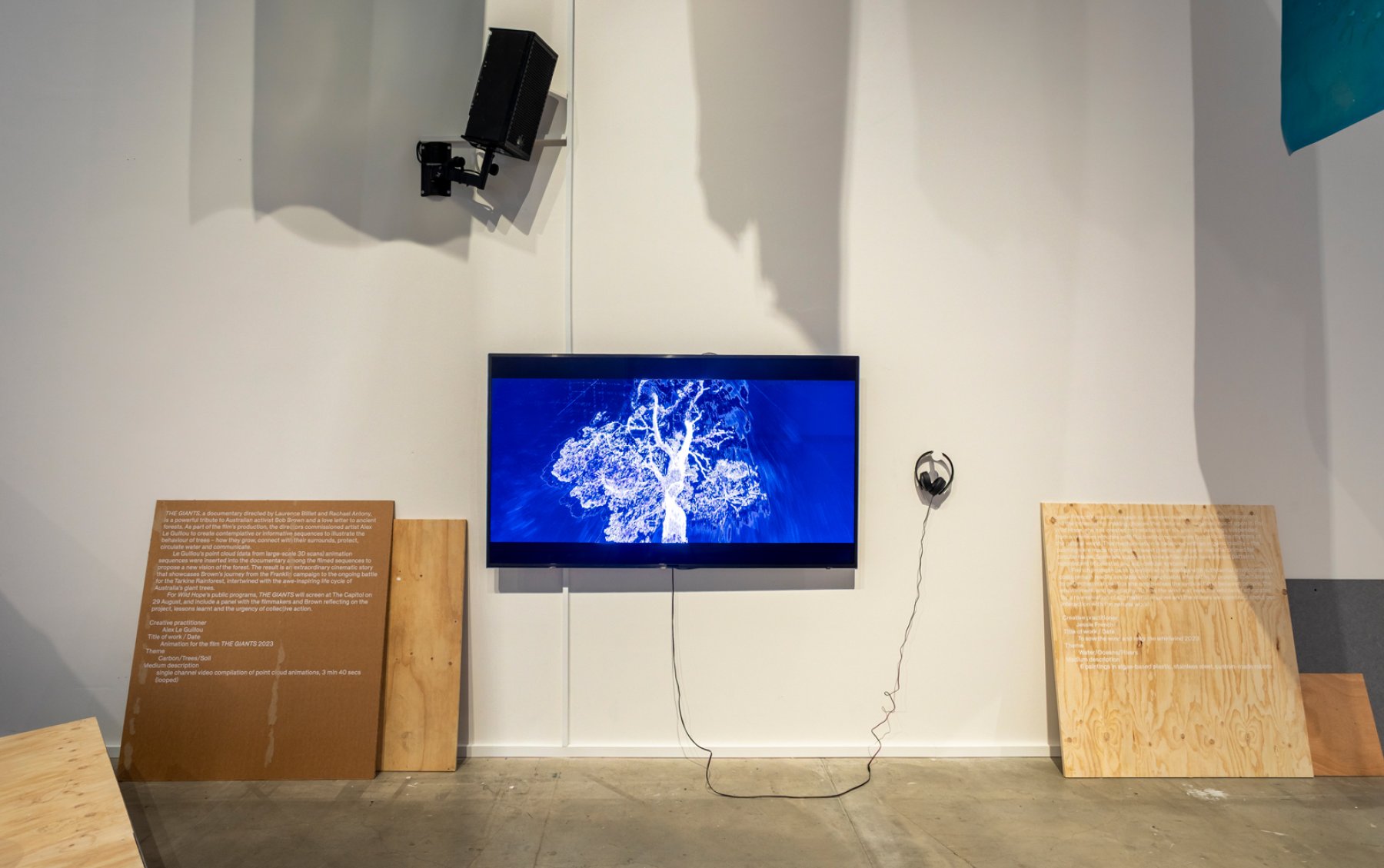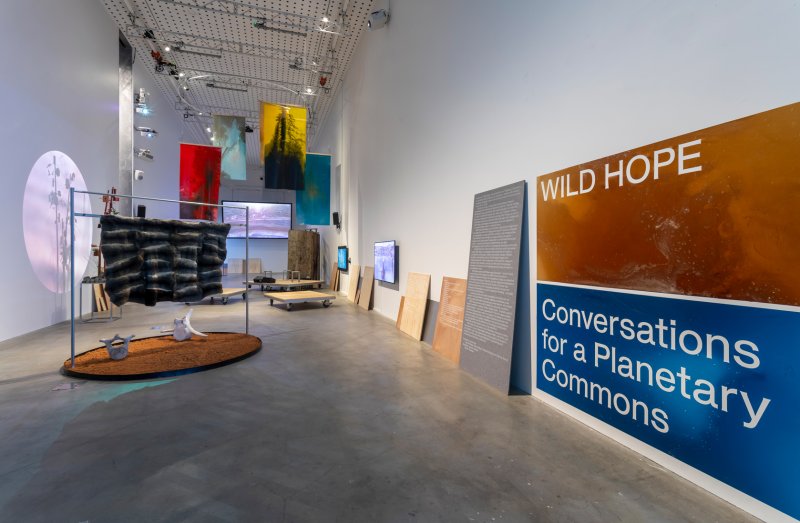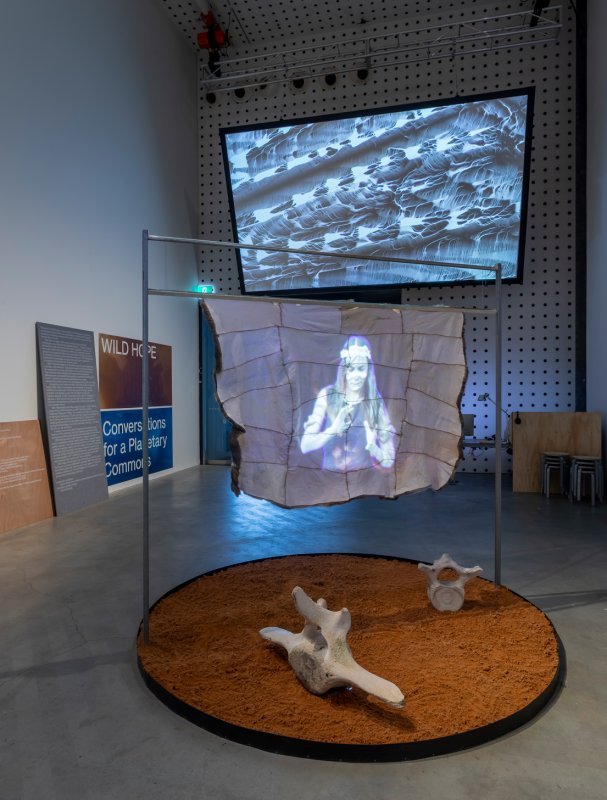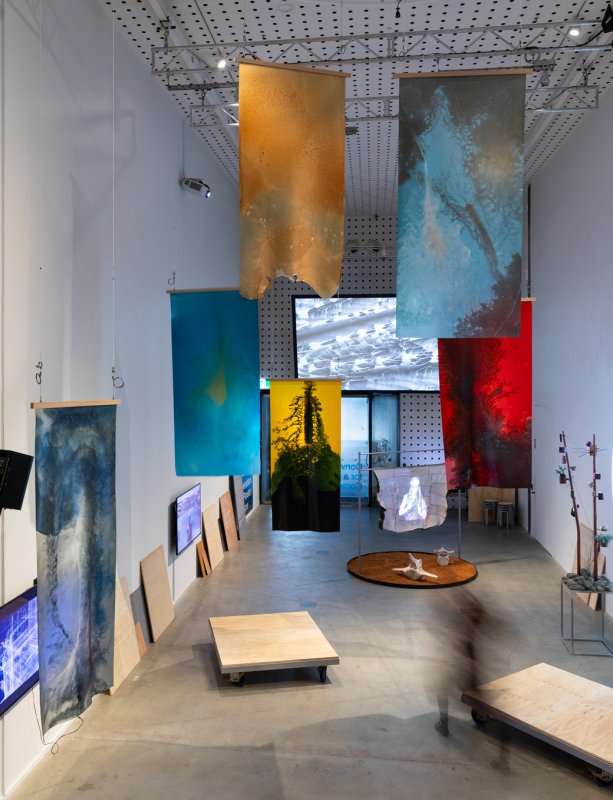The Mirror
EditorialAboutA+a Study CentreA+a ArchiveShopClose Menu

The dark, austere, modernist, basement of RMIT’s Design Hub, deep in the metropolis, isn’t exactly where you’d think you’d find a ‘radical shift towards “planetary thinking”’, but for the exhibition Wild Hope that is exactly what it strives for. The cavernous space is teeming with over twenty, research-driven works from practitioners and collaborative groups across art, architecture, material sciences, and landscape, digital and textile design. Titled in full; Wild Hope: Conversations for Planetary Commons, was produced as part of City of Melbourne’s new Now or Never 2023 festival, a multi-day, city-wide initiative. Its tagline? ‘The future is now’. Wild Hope then seems to be asking; if the future is now—a time of climate-, housing-, employment-, resource-, and health- crises—then what glimmers of hope might we consider?
Here, in the bowels of the University, garnished with large wall labels, and a throng of public programs, Wild Hope has a pedagogical sensibility. Unlike much of the Now or Never program with its neon colours, computer cables, wires, and trendy 3D visual design, Wild Hope is visually grounded in the earthy and natural, in a traditional sense. Upon entering to the exhibit you’re confronted with the whirring sounds of several video works (animals, water flowing, affectless voiceover) and endless earthy tones (muted browns, blue, green, yellow). Wood too, and lots of it. Here oversized plywood planks function as label texts, timber scaffolding frame video works, and wooden dollies punctuate the floor. If the crowded exhibition feels overwhelming upon first glance, perhaps that is precisely the point. It is an ambitious feat to take on such a sizable thematic such as ‘planetary commons’ in this time of poly-crisis. Wild Hope is a plea.
...
Setting the tone is Meerreeng Karweeyn—Earth Dance (2010, 2023), an intimate installation from Vicki Couzens, a Gunditjmara Keerray Woorroong woman, artist and RMIT Vice Chancellor's Indigenous Research Fellow. At its base is a circle of dark red sand, which earths a tall frame holding open a large, handmade possum skin cloak that hosts a projection. It reveals a woman, painted and adorned, telling story through movement. Couzens is a master possum skin cloak maker, her great-grandfather was one of six men who made a historic 1872 Lake Condah cloak, she has deeply studied both the history and revitilsation of cloak-making as it intersects with Country and cultural knowledges.1 Here, it’s almost as if you encounter Meerreeng Karweeyn from behind and are prompted to dance curiously around the cloak to intimately view the video on its opposing side. The work feels calm but the urgency is not, as the wall label states; ‘Indigenous patience has “worn thin”’. Couzens’ reminds viewers that if we’re to confront ecological crises then listening to Indigenous Ancestral and cultural knowledges is essential. Hope and ecological care are not only possible but already present. First Nations people have been caring for Country, waterways and multi-species lifeworlds for millennia.

Complementing Couzens’ work is an equally meditative, simple and slow video loop from Dean Cross, Untitled (Self-Portrait as Water and Clay) (2015), which shows the artist immersed in a waterhole in Ngunnawal and Nagambri Country, where he was born and raised. The scene appears overexposed, bright, and sunkissed, you feel almost like squinting just viewing it. Cross wipes his face and body, covering it with pale orchre collected nearby. It’s a candid gesture in connecting with his childhood, his Saltwater ancestry and familial environment. The world here is remarkably different to the world I just stepped outside of—the fast paced, tumultuous city that is constantly demolishing and metabolising itself, erasing its past.

Contrasting these deeply familial works is a nearby short video animation from Alex Le Guillou, originally made for and featured in THE GIANTS (2023) a film tribute to the Australian activist Bob Brown and ancient forests. Le Guillou’s point cloud animation took data from large-scale 3D scans to visualise the behaviour of trees and forests. Contextless here in the gallery, this video looked like it was taken straight from YouTube with its basic data infovis reduction and pointillist aesthetic.
Meanwhile, I’m almost hit on the head by an artwork lowered down above me. It’s one of Jessie French’s—To sow the wind and reap the whirlwind (2023)—algae-based plastic paintings that hope to prompt us to question our relationship to unsustainable materials such as petrochemical plastics. Suspended from custom-made robotic ceiling hangers, French’s work consists of six algae sheet paintings in green, blue, yellow, and red. They’re beautifully translucent like marbled venetian glass with abstracted patterns reminiscent of aerial views of rivers. But by this point in the exhibition, something was irking me, the overall aesthetic and relatively simple eco-criticsm was beginning to feel a bit rudimentary all together. I found myself looking for the edge, looking for the wild, the grassroots, a sense of the unruly. Perhaps I was demanding too much of Wild Hope, a RMIT and City of Melbourne produced exhibition.

Strangely, for a show on hope, I found the most compelling works were not only the most melancholic, but also rooted in complicated criticism that highlighted the fundamentally entangled forces of planetary ecologies whether they be human, nature, or otherwise. Towards the end of Design Hub’s cavernous first hall is a large 21-minute-long video essay, Aurum (2020), from Georgia Nowak and Eugene Perepletchikov. Taking gold as its object of study, Aurum indexes the mineral’s complex webbing between humans, land, labour, history, nation-building and mythology. Comprised of slow pans across cavernous mine sites, shaft tunnels, heavy machinery, and industrious goldsmithing, Aurum speaks with an impassive voice over; ‘Today the machines continuously chew through the earth’. We both hear and see a sense of the metabolism of the industry as machinery churns, and a sense of a complicated unregulated goldsmithing industry; ‘The miners are left with a nugget in their hand and the mercury in their lungs’.
Aurum sits in dialogue with works by early-career artists from (so-called) Australia, such as Lu Forsberg’s investigative video works on coal mining and colonial extractive capitalism, or Gadigal-based, Wiradjuri Joel Sherwood Spring who recently won the Churcie Prize with his video Diggermode (2023), which unearths relationships between mining, policing, capturing, property-making, dispossesion, and material memories of Country. Practitioners working in this milieu importantly situate us, as Aurum reminds us, ‘Gold built our universities and our monuments’. By coincidence, I was visiting the exhibition with some teachers who were on strike for sustainable, secure, and better working conditions—to me that’s where the wild hope was happening.
Closing the exhibition is a new work from Machine Listening, the collective trio of Sean Dockray, James Parker, and Joel Stern who have long been producing heavily researched, collaborative, and speculative works. Taking the form of a 35 minute sound installation, accompanied by vinyl record, sleeves, and a turntable, Environment’s 12 is like ASMR and automated mood-based playlisting with a retro spin. The hipster aesthetic isn’t for kitsch nostalgia sake, instead Environment’s 12 is a speculative addition to a sequence of popular records, Environment Series, released between 1969-1979. The original series featured field recordings of natural environments, think: waves crashing, thunderstorms, cicadas, birds—but heard from the comfort of your home! In Machine Listening’s version, the fifteen tracks traverse through eco-soundscapes that are acoustically enhanced, speculative, historical or oral histories, semi-automated vocalisations, and songs such as ‘reef lullabies’. Voice cloning technology is used throughout the work to create an eerie chorus of voices, something more-than-human, something other-than, otherwise possibilities, probable and otherwise futures.

Bringing weather-worlds into immediate relief, Environments 12, draws on what is commonly disregarded as an ‘outside’ phenomena or external background to remind us how our environments fundamentally intersect with and co-produce our material worlds. It produces a sonic atmosphere indexing a kind of ecogrief. For example, in ‘Reef Lament’ we hear a planet ‘forced to sing itself back to health’. Or in ‘Conversations we can’t understand’, it references a founder from Google’s Earth Species Project and a paper on climate change which imagines ‘alarm systems for animals’ in fire-prone forests that would use animal voice clones. Machine Listening’s work considers the ecology of technology and the technologies of ecologies. The whole work is eerie, uncanny, and difficult to sit through because of that. But somewhere along the way it feels like the ambitious plea of Wild Hope is really being sung.
Wild Hope: Conversations for Planetary Commons, 15 August 2023 - 30 September 2023
RMIT Design Hub Gallery. Part of the City of Melbourne’s Now or Never festival
Exhibitors: Marnie Badham and Tammy Wong Hulbert; Vicki Couzens; Dean Cross; D&K (Chantal Kirby, Ricarda Bigolin) with Žiga Testen; Jessie French; Kate Geck; Marc Gibson; Pirjo Haikola, Tom Park; Kirsten Haydon; Openwork, Sarah Lynn Rees with RMIT ICON Science; Alex Le Guillou; Grace Lillian Lee; Machine Listening (Sean Dockray, James Parker & Joel Stern); Clare McCracken, Rebecca Najdowski and Polly Stanton; Georgia Nowak and Eugene Perepletchikov; Caitlyn Parry & Helen Duong; Maj Plemenitas; RMIT Architecture Immersive Futures Lab and Superscale (Patrick Macasaet, Vei Tan, Shuming Ivy Zhou and Zechen Huang); David Rousell and Amy Cutter-Mackenzie-Knowles; Greg Semu; These Are The Projects We Do Together (Millie Cattlin and Joseph Norster)
Curatorium: Naomi Stead, Fleur Watson, Wendy Steele, Katrina Simon
1. Vicki Couzens, Possum skin cloak story reconnecting communities and culture: telling the story of possum skin cloaks Kooramookyan-an Yakeeneeyt-an Kooweekoowee-yan, 2017, https://researchrepository.rmit.edu.au/esploro/outputs/doctoral/Possum-skin-cloak-story-reconnecting-communities-and-culture-telling-the-story-of-possum-skin-cloaks-Kooramookyan-an-Yakeeneeyt-an-Kooweekoowee-yan/9921864010701341, accessed 25 September 2023.
Author/s: Audrey Pfister
Audrey Pfister. 2023. “Review, Wild Hope: Conversations For Planetary Commons.” Art and Australia 58, no.2 https://artandaustralia.com/58_2/p179/review-wild-hope
Art + Australia Editor-in-Chief: Su Baker Contact: info@artandaustralia.com Receive news from Art + Australia Art + Australia was established in 1963 by Sam Ure-Smith and in 2015 was donated to the Victorian College of the Arts at the University of Melbourne by then publisher and editor Eleonora Triguboff as a gift of the ARTAND Foundation. Art + Australia acknowledges the generous support of the Dr Harold Schenberg Bequest and the Centre of Visual Art, University of Melbourne. @Copyright 2022 Victorian College of the Arts The views expressed in Art + Australia are those of the contributing authors and not necessarily those of the editors or publisher. Art + Australia respects your privacy. Read our Privacy Statement. Art + Australia acknowledges that we live and work on the unceded lands of the people of the Kulin nations who have been and remain traditional owners of this land for tens of thousands of years, and acknowledge and pay our respects to their Elders past, present, and emerging. Art + Australia ISSN 1837-2422
Publisher: Victorian College of the Arts
University of Melbourne
Editor at Large: Edward Colless
Managing Editor: Jeremy Eaton
Art + Australia Study Centre Editor: Suzie Fraser
Digital Archive Researcher: Chloe Ho
Business adviser: Debra Allanson
Design Editors: Karen Ann Donnachie and Andy Simionato (Design adviser. John Warwicker)
University of Melbourne ALL RIGHTS RESERVED
